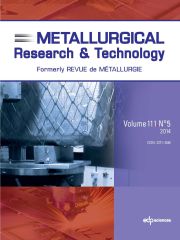Article contents
Wear mechanisms of Al2O3-MgOspinel-forming refractories used in steel ladle impact pads
Published online by Cambridge University Press: 10 January 2014
Abstract
Refractory castables containing alumina-magnesia/self-forming spinel(MgAl2O4) are used in impact pads of steel ladles in steelmakingprocesses. In order to understand the wear mechanisms of refractory materials, severalrecipes were tested from a corrosion, slag resistance and thermal shock point of view. Theresults show that the corrosion is extremely limited at the slag/refractory interface forall cases. Nevertheless, for higher cement alumina content castables, the formation ofcracks is observed in refractory castables into which slag can penetrate. The slag reactswith the alumina to form a new phase such as hibonite (CA6) and calcium dialuminate (CA2).The volumetric change of these reactions involving CA2 and CA6 lead to the apparition ofmacro-cracks. Thus, the penetration of slag and steel are increased, causing hotmechanical properties to degrade. For lower cement alumina castables, the formation ofmicro-cracks is avoided by controlling volume expansion. Thus, the slag deposit reactswith alumina grains and the matrix at the slag/refractory interface to produce amonomineral layer of hibonite. In this way, the monomineral layer acts as a barrier andlimits the penetration of slag and steel into the refractory lining. Thus, to increase thelifetime of refractory castables containing alumina-magnesia/self-forming spinel, it isadvised to control volume expansion in order to avoid the formation of cracks and limitthe penetration of secondary metallurgy steel ladle slag.
- Type
- Research Article
- Information
- Copyright
- © EDP Sciences 2014
References
- 3
- Cited by


